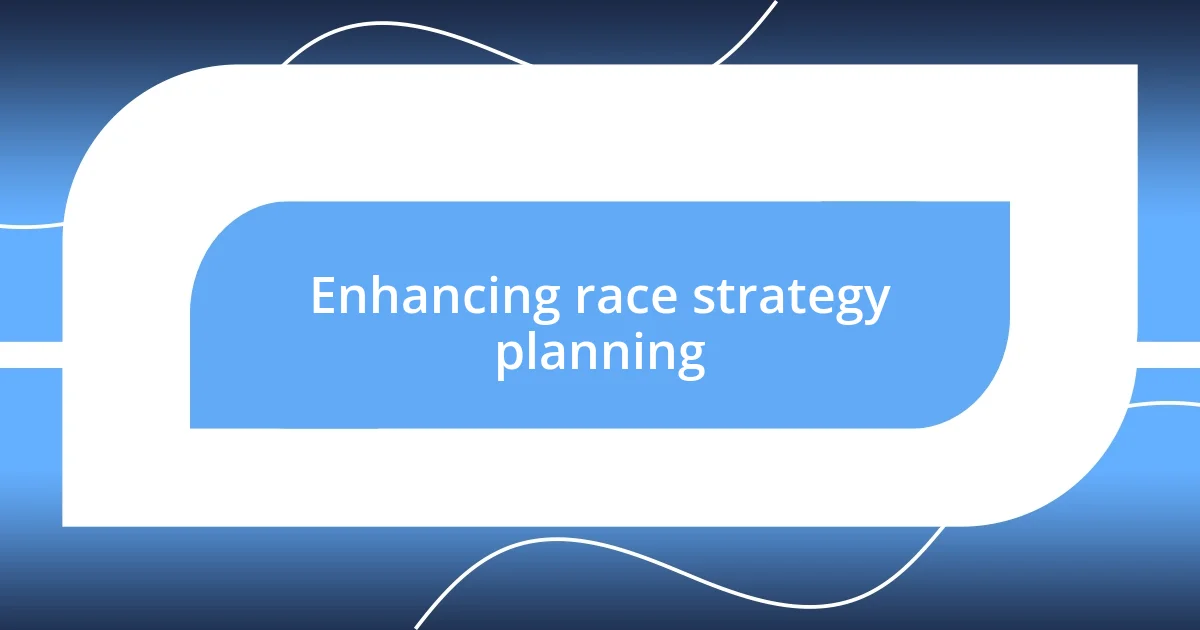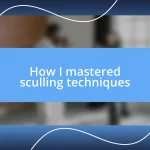Key takeaways:
- Safety and leadership are paramount responsibilities of a coxswain, requiring quick decision-making and clear communication to ensure crew cohesion and trust.
- Setting clear, actionable team goals fosters accountability and enhances team dynamics, motivating members to improve both individually and collectively.
- Continuous reflection on performance—through feedback, self-assessment, and strategic planning—leads to significant growth, better communication, and effective race strategies.

Understanding coxswain responsibilities
A coxswain is more than just a helmsperson; they are the heartbeat of the crew. From my own experience, I remember that exhilarating yet nerve-wracking moment before a race when it hit me just how crucial my role was. Was I prepared to guide my teammates through the chaos of competition? Understanding the responsibilities of a coxswain means embracing that leadership position, making split-second decisions, and ensuring everyone is synchronized and focused.
Safety is a paramount concern for any coxswain. I vividly recall an early morning practice when our boat almost capsized due to unexpected wind conditions. It taught me that vigilance and quick thinking aren’t just beneficial; they are essential. A coxswain must constantly assess the environment and communicate potential hazards to the crew. How could I have improved that day? It sparked a deeper commitment in me to prioritize safety, which in turn strengthened my confidence and trust among my teammates.
Another critical aspect involves fostering team cohesion and communication. I’ve found that the coxswain’s voice is often the linchpin during both training and competition. During one challenging practice, I facilitated a team discussion, encouraging everyone to share their thoughts on our performance. This not only boosted morale but also created a shared sense of responsibility. I often wonder, how could I enhance that dialogue further? Understanding these dynamics has transformed my approach to coxing, ensuring I not only lead but also listen and support my crew.

Setting clear team goals
Setting clear team goals is a vital element of effective coxswaining. I remember one particular season when we established a goal to improve our race times by two seconds. Initially, it felt daunting, but breaking that goal into smaller, actionable steps made it achievable. We tracked our progress week by week, and seeing those small improvements sparked a collective motivation within the crew that was palpable. It was a magical moment when the team celebrated our successful time trial; the sense of unity was exhilarating.
During another season, we set a goal focused on enhanced communication. I created a simple strategy where each rower would call out their counts during drills. This approach not only streamlined our rhythm but also encouraged each member to take ownership of their performance. I couldn’t help but notice the increase in engagement—rowers became more attuned to one another, and it shaped a stronger bond among us. Watching them step up and communicate effectively during races was genuinely empowering.
Ultimately, setting clear goals fosters accountability and growth within the team. Reflecting on my journey as a coxswain, I realize that it’s not just about accomplishing targets; it’s about the relationships we build along the way. Each goal achieved adds another layer to our collective experience. Watching my teammates evolve and push boundaries encourages me to lead with intention and purpose.
| Type of Goal | Outcome |
|---|---|
| Improve Race Times | Created motivation and unity through measurable progress |
| Enhance Communication | Developed stronger connections and ownership among crew members |
| Foster Accountability | Encouraged a culture of growth and support |

Developing effective communication skills
When it comes to developing effective communication skills as a coxswain, I’ve learned just how vital clarity is in every instruction and motivation I offer. One memorable practice, I found myself struggling to convey a last-minute strategy change during a particularly tense drill. The air was thick with anticipation, and I could see the confusion on my crew’s faces. I realized then that being concise is not just about what I say, but also how I say it—tone, pacing, and certainty all play a role. Since that day, I always ask myself, “Am I clear enough?” This reflects how communication is a dance; it requires synchronization and an understanding of rhythm, just like rowing itself.
Here’s what I’ve focused on to enhance my communication skills:
- Active Listening: I always listen to feedback and adjust my approach accordingly, fostering a culture of open dialogue.
- Non-Verbal Cues: I’ve become more aware of my body language and facial expressions, ensuring they align with my verbal messages to create a cohesive communication style.
- Clear, Direct Instructions: I practice using simple, straightforward language to ensure my commands are easily understood, especially under pressure during races.
- Encouraging Team Input: By inviting rowers to share their thoughts, I create a sense of shared responsibility and commitment, which ultimately improves our performance.
- Consistent Check-Ins: During practice, I pause to gauge whether everyone is on the same page, reinforcing understanding and unity among the team.
With these techniques, I’ve noticed a remarkable shift in how my crew responds, both during drills and races. It’s empowering to see how engaged and connected we’ve become. Each voice, including my own, plays a part in our collective success.

Practicing navigation techniques
Mastering navigation techniques has been a transformative journey for me as a coxswain. I remember a time when I found myself fumbling with a map during a practice race. The anxiety hit me like a wave as I realized my crew depended on me to steer us through tricky waters. To sharpen my navigation skills, I started plotting courses ahead of time and practicing with landmarks. This proactive approach allowed me to visualize our route clearly, reducing my stress and enhancing my crew’s trust in my decision-making.
I believe that repetition is key in developing these skills. During one practice session, I took my crew on a route I had never navigated before. I felt a mix of excitement and apprehension, knowing that each stroke required sharp focus. We trained on using the wind and currents to our advantage while I called out directions. To my relief, my crew adapted swiftly, and it felt incredible to see our cohesive teamwork pay off, as we sliced through the water smoothly. This experience reinforced a simple yet profound lesson: the more we practiced, the more capable and confident we became.
Engaging in conversations with other coxswains also enriched my navigation skills significantly. I recall asking a fellow coxswain how they handle adverse conditions. Their response about utilizing technology—like GPS devices and apps—opened my eyes to new possibilities. Motivated by this insight, I experimented with navigation apps during practices to track our progress. Have you ever considered how a little tech can enhance your skills? Embracing these tools not only streamlined our routes but also improved communications, making every practice feel like an impactful learning experience.

Enhancing race strategy planning
Enhancing race strategy planning has been a game-changer for me as a coxswain. I remember a pivotal race where my crew and I faced strong competitors with well-defined tactics. In our pre-race huddle, I gathered everyone’s insights on how to exploit our strengths against the competition. It’s fascinating how these discussions unearth unique perspectives. Have you ever noticed how collaboration often leads to a strategy you might not have considered? That day, our combined ideas formed a cohesive plan that boosted our confidence.
In honing our race strategy, I learned the importance of real-time adaptability. During one particularly challenging race, I had to adjust our approach on the fly when unexpected conditions arose. It was a whirlwind moment, filled with pressure and uncertainty. Yet, embracing those changes felt exhilarating. I shouted directions with a calm voice, and my crew responded brilliantly, showcasing their resilience and readiness. This experience emphasized that the best strategies are fluid, allowing us to pivot when needed.
One practice session, I decided to implement a “what-if” strategy brainstorming exercise with my crew. Questions like, “What if we encounter rough waters?” or “What if the wind shifts?” sparked dynamic discussions. Everyone contributed, and the energy was infectious. Feeling that camaraderie and shared ownership of our plan made a significant difference. When we finally executed our strategies in a race, the sense of unity and preparation propelled us forward. Isn’t it amazing how anticipating challenges can transform them into opportunities for growth? That’s the power of proactive planning!

Receiving and implementing feedback
Receiving and implementing feedback has been vital in elevating my coxswain skills. Early on, I dreaded feedback; I thought it was a critique of my abilities. Then, I had a transformative moment during a practice when my coach pointed out specific areas for improvement in my voice commands. It felt uncomfortable at first, but I soon realized that these insights were stepping stones to becoming a more effective leader. Have you experienced that uncomfortable moment when feedback actually leads to significant growth?
Once I shifted my mindset about feedback, I actively sought it from both my coach and my crew. I would ask them how I could enhance our communication during races. One crew member mentioned that my calls could be clearer during high-stress situations, especially when we were trying to catch up in a race. Armed with this knowledge, I made a conscious effort to articulate my commands with more clarity and assurance. How does it feel to know that your team values input that can strengthen your performance?
Implementing this newfound focus on feedback took practice and commitment, but the results were worth it. I began to view feedback as a treasure map, guiding me towards improvement. After races, I held debriefings to discuss what went well and what needed tweaking. Gradually, the atmosphere shifted; my crew became more vocal about their experiences too. The sense of trust blossomed, and I found that a well-rounded understanding of their perspectives not only made our teamwork more robust but also fostered a richer, more enjoyable rowing experience. Isn’t it amazing how constructive dialogue can transform not just your skills but also your team dynamics?

Continuously reflecting on performance
In my journey as a coxswain, I’ve discovered that continuously reflecting on performance can be incredibly revealing. After every race, I take a moment to sit down with my thoughts, often feeling a mix of pride and frustration. It’s during these reflections that the ‘aha’ moments happen—like realizing I could have communicated our strategy with more urgency in a close race. Have you ever found that your most important lessons emerge not from success, but from setbacks?
During one season, the practice of self-reflection became my secret weapon. I started recording my calls and then listened to the playback. The first time I did this, I cringed at the sound of my own voice—was I really that unclear? However, each listen made me more aware of the nuances in my communication style. I began employing techniques to modulate my voice for different situations, leading to a noticeable improvement in crew responsiveness. It’s empowering to witness how a little self-scrutiny can lead to profound growth.
I’ve also found writing down my post-race thoughts helps solidify my insights. One evening, I penned my reflections after a particularly tough competition, and something clicked: I realized the importance of visualizing our map on the water before the race started. This simple practice helped my crew envision what was ahead, easing pre-race jitters. Have you ever discovered a small tweak that made a big difference? That’s the beauty of continuous performance reflection—it’s not just about what we did but about understanding why we did it.














